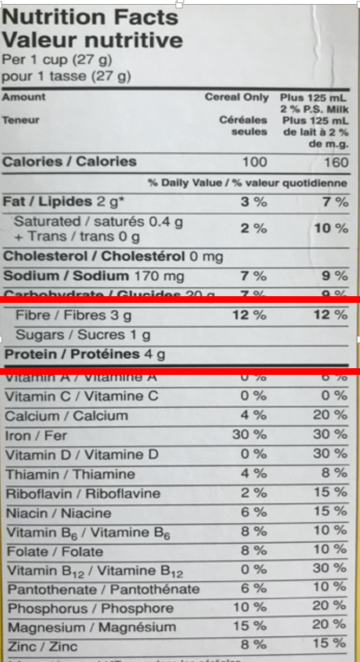Choosing Carbohydrate Foods
Carbohydrates are an important source of energy and other nutrients for children and adults. Carbohydrates are present in foods in different ways. For example, sugar is a carbohydrate, and it is naturally present in fruits and plain unsweetened milk. Sugar can also be added to beverages or foods, and it is this type of added sugar that should be limited.
Starchy foods like grains and legumes are also rich in carbohydrates, called complex carbohydrates. When choosing grain foods, opt for whole grains more often because they include fiber and other essential nutrients. Fiber plays an essential role in our gut health as well as keeping us full for longer.
Processed grain foods are often refined, which means the fiber naturally present has been partially or totally removed.
Using Labels to Choose Carbohydrate Foods:
Use the % Daily Value on the Nutrition Facts Table:
- 15% Daily Value is considered a lot of a nutrient
- Choose carbohydrate foods that have a lot of fiber (~15% Daily Value)
Use the grams of nutrients in the Nutrition Facts Table:
- Sugar is not listed with a % Daily Value
- Use the grams of sugar and try to choose products with less sugar than fiber (by grams)
Use the ingredient list:
- Choose carbohydrate foods with whole grains listed rather than refined/white flour
- Limit choosing carbohydrate foods with sources of added sugar in the first 3 ingredients as that means sugar is a major ingredient in the product
- Keep in mind sugar can be listed as glucose, fructose, modified or high fructose corn syrup, barley malt, fruit juice concentrate, honey, maple syrup, agave nectar, dextrose, cane juice, molasses, lactose, etc.
For example, this is a breakfast cereal food label. One cup of cereal has:
- 3 grams fibre (12% daily value)
- 1 gram of sugar (less than the grams of fibre)

Then, this breakfast cereal is a good source of fibre and also has limited amounts of added sugar.
For more info:
https://www.canada.ca/en/health-canada/services/nutrients/carbohydrates.html
